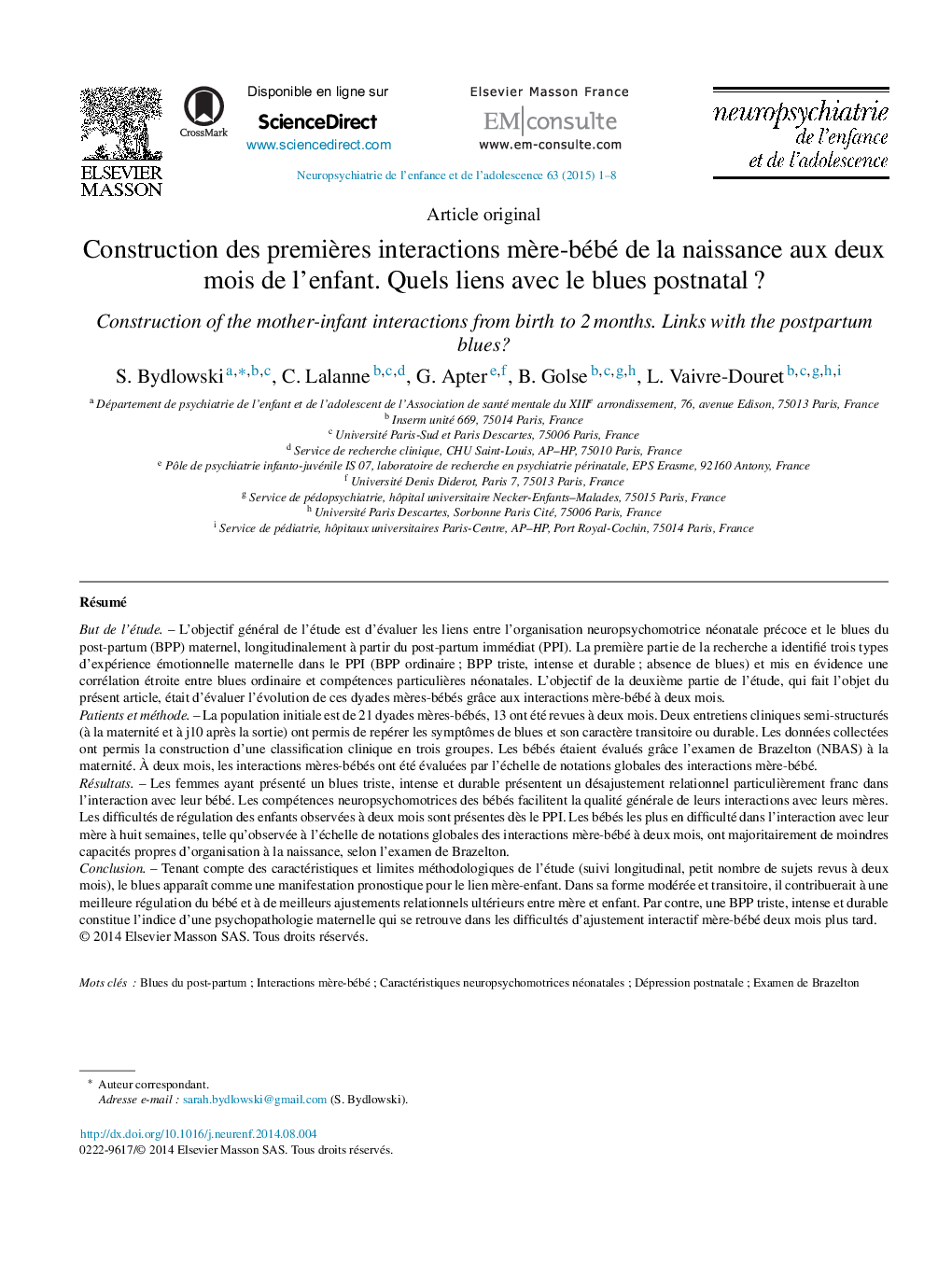| کد مقاله | کد نشریه | سال انتشار | مقاله انگلیسی | نسخه تمام متن |
|---|---|---|---|---|
| 943791 | 925560 | 2015 | 8 صفحه PDF | دانلود رایگان |

RésuméBut de l’étudeL’objectif général de l’étude est d’évaluer les liens entre l’organisation neuropsychomotrice néonatale précoce et le blues du post-partum (BPP) maternel, longitudinalement à partir du post-partum immédiat (PPI). La première partie de la recherche a identifié trois types d’expérience émotionnelle maternelle dans le PPI (BPP ordinaire ; BPP triste, intense et durable ; absence de blues) et mis en évidence une corrélation étroite entre blues ordinaire et compétences particulières néonatales. L’objectif de la deuxième partie de l’étude, qui fait l’objet du présent article, était d’évaluer l’évolution de ces dyades mères-bébés grâce aux interactions mère-bébé à deux mois.Patients et méthodeLa population initiale est de 21 dyades mères-bébés, 13 ont été revues à deux mois. Deux entretiens cliniques semi-structurés (à la maternité et à j10 après la sortie) ont permis de repérer les symptômes de blues et son caractère transitoire ou durable. Les données collectées ont permis la construction d’une classification clinique en trois groupes. Les bébés étaient évalués grâce l’examen de Brazelton (NBAS) à la maternité. À deux mois, les interactions mères-bébés ont été évaluées par l’échelle de notations globales des interactions mère-bébé.RésultatsLes femmes ayant présenté un blues triste, intense et durable présentent un désajustement relationnel particulièrement franc dans l’interaction avec leur bébé. Les compétences neuropsychomotrices des bébés facilitent la qualité générale de leurs interactions avec leurs mères. Les difficultés de régulation des enfants observées à deux mois sont présentes dès le PPI. Les bébés les plus en difficulté dans l’interaction avec leur mère à huit semaines, telle qu’observée à l’échelle de notations globales des interactions mère-bébé à deux mois, ont majoritairement de moindres capacités propres d’organisation à la naissance, selon l’examen de Brazelton.ConclusionTenant compte des caractéristiques et limites méthodologiques de l’étude (suivi longitudinal, petit nombre de sujets revus à deux mois), le blues apparaît comme une manifestation pronostique pour le lien mère-enfant. Dans sa forme modérée et transitoire, il contribuerait à une meilleure régulation du bébé et à de meilleurs ajustements relationnels ultérieurs entre mère et enfant. Par contre, une BPP triste, intense et durable constitue l’indice d’une psychopathologie maternelle qui se retrouve dans les difficultés d’ajustement interactif mère-bébé deux mois plus tard.
BackgroundThe overall objective of the study is to assess the relationship between early neonatal neuropsychomotor organization and maternal postpartum blues (PPB), studied longitudinally from immediate postpartum (IPP). The first part of the research identified three types of maternal emotional experience in the IPP (ordinary and emotionally mixed PPB; sad, intense and lasting PPB; without blues) and showed a strong correlation between ordinary blues and a set of specific skills in neuropsychomotrice organization, coordination, and maturity in their infants. Postpartum blues may promote a certain openness to emotional exchange between mother and her infant. Maternal psychological experience of this particular type of PPB could therefore facilitate the adjustment of the mother to her baby and allow him a better development of his self-regulatory capacity. The objective of the second part of the study, which is the subject of this publication, was to evaluate the evolution of the mother-infant dyads through mother-infant interactions at 2 months.MethodsTwenty-one mother-infant dyads were included at maternity wards. Two semi-structured clinical interviews (at the maternity and D10) have identified the symptoms and the degree of transient or lasting PPB. The data collected allowed the construction of a clinical classification into three groups. Newborns were examined using the NBAS. At 2 months, 13 dyads were reviewed, assessment of mother-infant interactions allowed us to complete the Global Ratings for Mothers-Infant Interactions at 2 months.FindingsWomen with sad, intense and lasting PPB present a particularly straightforward relational mismatch in the interaction with their baby. The neuropsychomotrices skills and tonic postural babies facilitate the overall quality of their interactions with their mothers, regardless of the adjustment of the latter, even if the “cost” for the child to maintain a good relationship adjustment is probably higher when the mother has difficulty dealing with the child and the interaction. Our results suggest that these infant's regulatory capacities observed at 2 months-aged are to be connected to the characteristics during the IPP. Among the 8-week-old babies whose interactions were the most distorted with their mothers, as showed at the Global Ratings for Mothers-Infant Interactions at 2 months, a majority had less positive self-organization at birth at the Brazelton's examination. From birth to 2 months, our results show a form of coherent continuity: the presence of an ordinary and emotionally mixed PPB and high scores on the NBAS items at birth promote quality of mother-infant interactions a few weeks later. Conversely, when a number of maternal’ and infantile’ characteristics are negatively oriented at birth, interactions may be affected. Mother-infant’ interactions at 2 months show lack of mutuality and harmony when the mother was afflicted with a sad, intense and lasting PPB and her infant had low scores on the NBAS.ConclusionTaking into account the characteristics and methodological limitations of the study (longitudinal study, few subjects reviewed at 2 months), the blues appears as a prognostic manifestation for the mother-child bond. Ordinary and emotionally mixed BPP would contribute to a better regulation of the baby and to a better adjustment of the mother-child relation. Conversely, sad, intense and lasting PPB is the index of a maternal psychopathology, which is reflected in interactive difficulties mother-baby 2 months later.
Journal: Neuropsychiatrie de l'Enfance et de l'Adolescence - Volume 63, Issue 1, January 2015, Pages 1–8